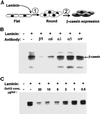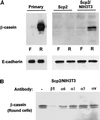Division of labor among the alpha6beta4 integrin, beta1 integrins, and an E3 laminin receptor to signal morphogenesis and beta-casein expression in mammary epithelial cells
- PMID: 10473629
- PMCID: PMC25520
- DOI: 10.1091/mbc.10.9.2817
Division of labor among the alpha6beta4 integrin, beta1 integrins, and an E3 laminin receptor to signal morphogenesis and beta-casein expression in mammary epithelial cells
Abstract
Contact of cultured mammary epithelial cells with the basement membrane protein laminin induces multiple responses, including cell shape changes, growth arrest, and, in the presence of prolactin, transcription of the milk protein beta-casein. We sought to identify the specific laminin receptor(s) mediating the multiple cell responses to laminin. Using assays with clonal mammary epithelial cells, we reveal distinct functions for the alpha6beta4 integrin, beta1 integrins, and an E3 laminin receptor. Signals from laminin for beta-casein expression were inhibited in the presence of function-blocking antibodies against both the alpha6 and beta1 integrin subunits and by the laminin E3 fragment. The alpha6-blocking antibody perturbed signals mediated by the alpha6beta4 integrin, and the beta1-blocking antibody perturbed signals mediated by another integrin, the alpha subunit(s) of which remains to be determined. Neither alpha6- nor beta1-blocking antibodies perturbed the cell shape changes resulting from cell exposure to laminin. However, the E3 laminin fragment and heparin both inhibited cell shape changes induced by laminin, thereby implicating an E3 laminin receptor in this function. These results elucidate the multiplicity of cell-extracellular matrix interactions required to integrate cell structure and signaling and ultimately permit normal cell function.
Figures






Similar articles
-
Collagen-IV and laminin-1 regulate estrogen receptor alpha expression and function in mouse mammary epithelial cells.J Cell Sci. 2003 Jul 15;116(Pt 14):2975-86. doi: 10.1242/jcs.00523. J Cell Sci. 2003. PMID: 12808020 Free PMC article.
-
Laminin-dependent integrin β1 signaling regulates milk protein synthesis via prolactin/STAT5 pathway in bovine mammary epithelial cells.Biochem Biophys Res Commun. 2020 Apr 2;524(2):288-294. doi: 10.1016/j.bbrc.2020.01.086. Epub 2020 Jan 25. Biochem Biophys Res Commun. 2020. PMID: 31987497
-
Integrin binding specificity of laminin-10/11: laminin-10/11 are recognized by alpha 3 beta 1, alpha 6 beta 1 and alpha 6 beta 4 integrins.J Cell Sci. 2000 Mar;113 ( Pt 5):869-76. doi: 10.1242/jcs.113.5.869. J Cell Sci. 2000. PMID: 10671376
-
The integrin alpha 6 beta 4 and the biology of carcinoma.Biochem Cell Biol. 1996;74(6):811-21. doi: 10.1139/o96-087. Biochem Cell Biol. 1996. PMID: 9164650 Review.
-
Integrins as receptors for laminins.Microsc Res Tech. 2000 Nov 1;51(3):280-301. doi: 10.1002/1097-0029(20001101)51:3<280::AID-JEMT7>3.0.CO;2-O. Microsc Res Tech. 2000. PMID: 11054877 Review.
Cited by
-
Cell-matrix interactions in mammary gland development and breast cancer.Cold Spring Harb Perspect Biol. 2010 Oct;2(10):a003202. doi: 10.1101/cshperspect.a003202. Epub 2010 Aug 11. Cold Spring Harb Perspect Biol. 2010. PMID: 20702598 Free PMC article. Review.
-
In vitro propagation and transcriptional profiling of human mammary stem/progenitor cells.Genes Dev. 2003 May 15;17(10):1253-70. doi: 10.1101/gad.1061803. Genes Dev. 2003. PMID: 12756227 Free PMC article.
-
Raf-induced MMP9 disrupts tissue architecture of human breast cells in three-dimensional culture and is necessary for tumor growth in vivo.Genes Dev. 2010 Dec 15;24(24):2800-11. doi: 10.1101/gad.1990410. Genes Dev. 2010. PMID: 21159820 Free PMC article.
-
Demystifying the effects of a three-dimensional microenvironment in tissue morphogenesis.Methods Cell Biol. 2007;83:547-83. doi: 10.1016/S0091-679X(07)83023-8. Methods Cell Biol. 2007. PMID: 17613324 Free PMC article.
-
Dystroglycan: emerging roles in mammary gland function.J Mammary Gland Biol Neoplasia. 2003 Oct;8(4):409-19. doi: 10.1023/B:JOMG.0000017428.38034.a7. J Mammary Gland Biol Neoplasia. 2003. PMID: 14985637 Review.

